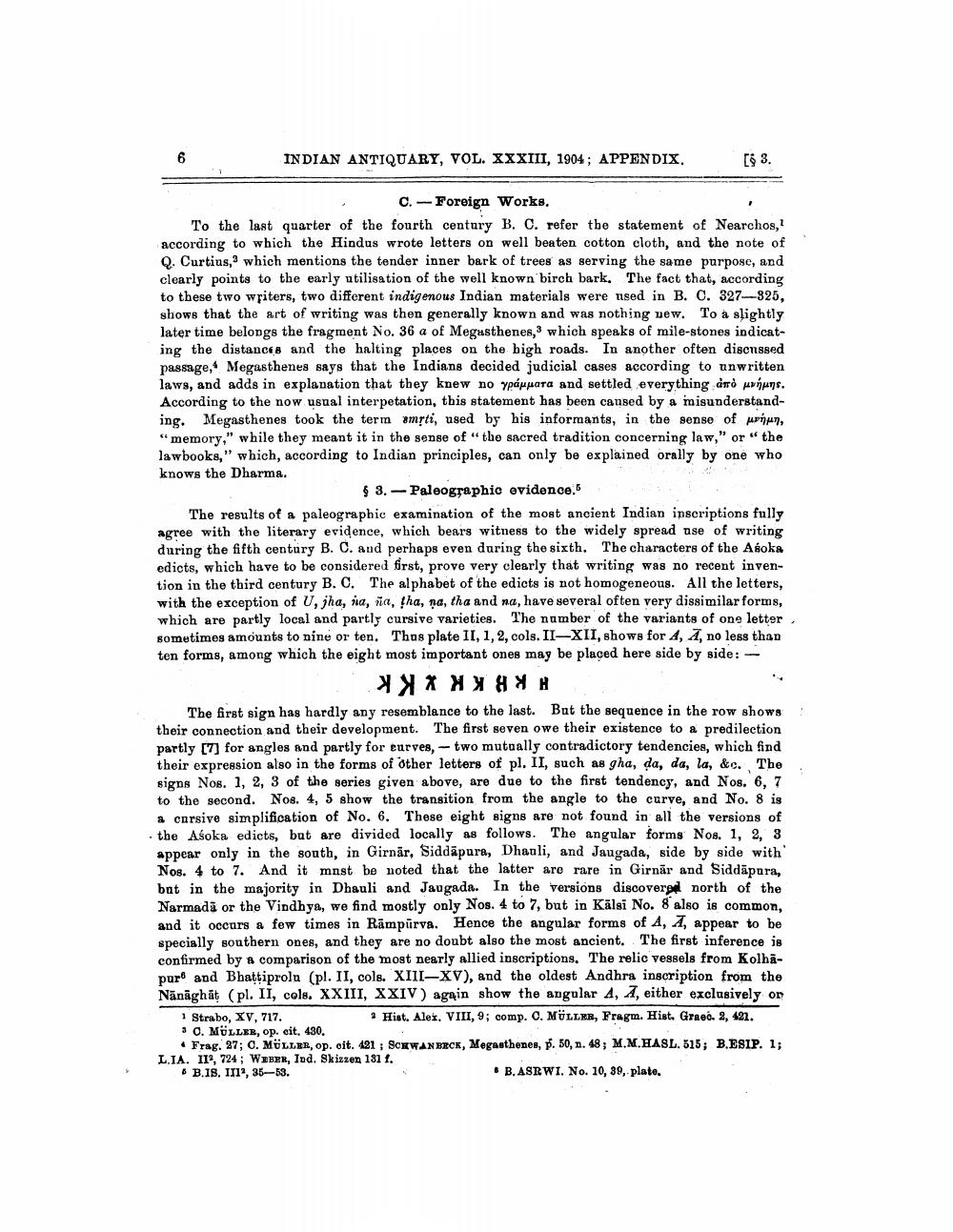________________
INDIAN ANTIQUARY, VOL. XXXIII, 1904; APPENDIX.
[$ 3.
C. -Foreign Works. To the last quarter of the fourth century B. C. refer the statement of Nearchos, according to which the Hindus wrote letters on well beaten cotton cloth, and the note of Q. Curtius, which mentions the tender inner bark of trees as serving the same purpose, and clearly points to the early utilisation of the well known birch bark. The fact that, according to these two writers, two different indigenous Indian materials were used in B. C. 327-325, shows that the art of writing was then generally known and was nothing new. To a slightly later time belongs the fragment No. 36 a of Megasthenes, which speaks of mile-stones indicating the distances and the halting places on the bigh roads. In another often discnssed passage, Megasthenes says that the Indians decided judicial cases according to unwritten laws, and adds in explanation that they knew no ypáupara and settled everything and pruuns. According to the now usual interpetation, this statement has been caused by a misunderstanding. Megasthenes took the term smrti, used by his informants, in the sense of uphun, “memory," while they meant it in the sense of "the sacred tradition concerning law," or "the lawbooks," which, according to Indian principles, can only be explained orally by one who knows the Dharma.
$ 3.-Paleographic evidence. The results of a paleographic examination of the most ancient Indian inscriptions fully agree with the literary evidence, which bears witness to the widely spread use of writing during the fifth century B. C. and perhaps even during the sixth. The characters of the Asoka edicts, which have to be considered first, prove very clearly that writing was no recent invention in the third century B. C. The alphabet of the edicts is not homogeneous. All the letters, with the exception of U, jha, iia, iia, tha, na, tha and na, have several often very dissimilar forms, which are partly local and partly cursive varieties. The number of the variants of one letter sometimes amounts to nine or ten. Thus plate II, 1,2, cols. II-XII, shows for A, Ā, no less than ten forms, among which the eight most important ones may be placed here side by side: -
яяяяяя н The first sign has hardly any resemblance to the last. But the sequence in the row shows their connection and their development. The first seven owe their existence to a predilection partly [7] for angles and partly for eurves, - two mutually contradictory tendencies, which find their expression also in the forms of other letters of pl. II, such as gha, da, da, la, &c. The signs Nos. 1, 2, 3 of the series given above, are due to the first tendency, and Nos. 6, 7 to the second. Nos. 4, 5 show the transition from the angle to the curve, and No. 8 is
carsive simplification of No. 6. These eight signs are not found in all the versions of · the Asoka edicts, but are divided locally as follows. The angular forms Nos. 1, 2, 3 appear only in the south, in Girnar, Siddāpura, Dhauli, and Jaugada, side by side with Nos. 4 to 7. And it mnst be noted that the latter are rare in Girnār and Siddapura, bat in the majority in Dhauli and Jaugada. In the versions discovered north of the Narmadā or the Vindhya, we find mostly only Nos. 4 to 7, but in Kälsi No. 8 also is common, and it occurs a few times in Rāmpūrva. Hence the angular forms of A, , appear to be specially southern ones, and they are no doubt also the most ancient. The first inference is confirmed by a comparison of the most nearly allied inscriptions. The relic vessels from Kolhapur and Bhattiprolu (pl. II, cols. XIII-XV), and the oldest Andhra inscription from the Nanachat (pl. II, cols. XXIII, XXIV) again show the angular A, 2, either exclusively on 1 Strabo, XV, 717.
Hist. Alex. VIII, 9; comp. C. MÜLLER, Fragm. Hist. Graeó. 2, 421. 30. MÜLLER, op. cit. 430.
• Frag. 27; O, MÜLLER, op. cit. 421 ; SCHWAN BECK, Megasthenes, p. 50, n. 48; M.M.HASL. 615; BESIP. 1; LIA. 112, 724; WEBER, Iod. Skizzen 131 f. B.IS, 111?, 35-53.
• B.ASRWI. No. 10, 39, plate.




